仁爱英语七年级下教案
- 格式:docx
- 大小:186.47 KB
- 文档页数:42
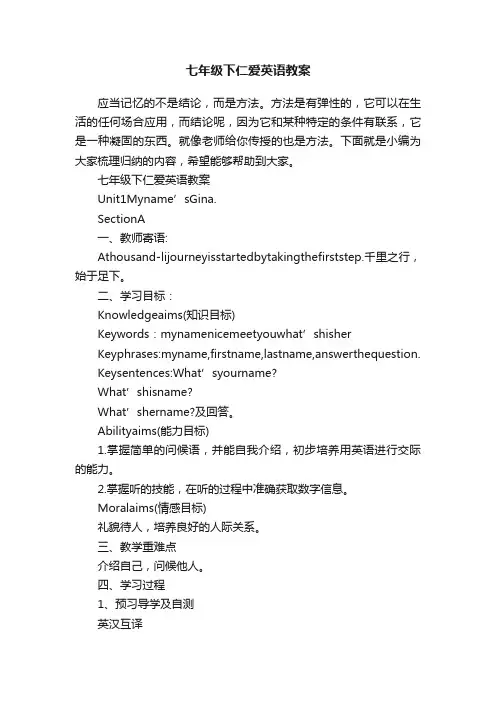
七年级下仁爱英语教案应当记忆的不是结论,而是方法。
方法是有弹性的,它可以在生活的任何场合应用,而结论呢,因为它和某种特定的条件有联系,它是一种凝固的东西。
就像老师给你传授的也是方法。
下面就是小编为大家梳理归纳的内容,希望能够帮助到大家。
七年级下仁爱英语教案Unit1Myname’sGina.SectionA一、教师寄语:Athousand-lijourneyisstartedbytakingthefirststep.千里之行,始于足下。
二、学习目标:Knowledgeaims(知识目标)Keywords:mynamenicemeetyouwhat’shisherKeyphrases:myname,firstname,lastname,answerthequestion.Keysentences:What’syourname?What’shisname?What’shername?及回答。
Abilityaims(能力目标)1.掌握简单的问候语,并能自我介绍,初步培养用英语进行交际的能力。
2.掌握听的技能,在听的过程中准确获取数字信息。
Moralaims(情感目标)礼貌待人,培养良好的人际关系。
三、教学重难点介绍自己,问候他人。
四、学习过程1、预习导学及自测英汉互译_________2.好的,令人愉快的______________3.too___________4.遇见______5.your____________6.his_________7.她的名字______2、自主学习①.onenum.1,一:Oneandtwomakesthree.一加二等于三。
adj.①一个:Ihaveonebook.我有一本书。
②有一(天):Onedayhewillunderstandyou.有一天他会理解你的。
②meet/mi:t/v.遇到,碰到【记忆法】-ee-双写,与meat为同音词。
【考点】tomeetsb.(orsth.)遇到某人/某事:Nicetomeetyou.初次见面时的客套话,不是初次见面时则用see。
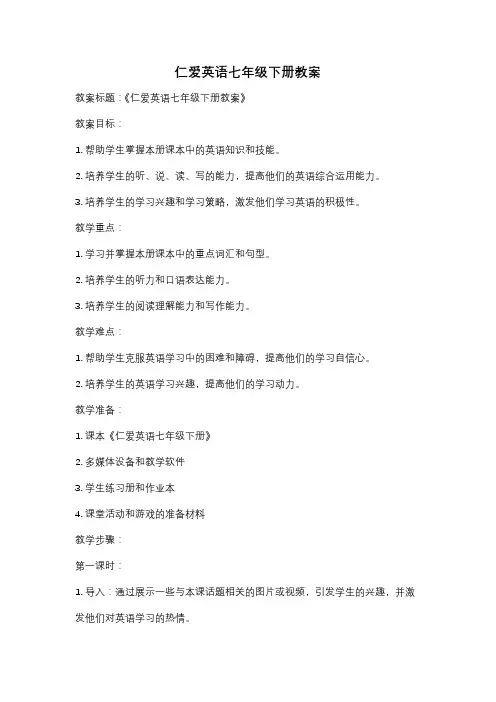
仁爱英语七年级下册教案教案标题:《仁爱英语七年级下册教案》教案目标:1. 帮助学生掌握本册课本中的英语知识和技能。
2. 培养学生的听、说、读、写的能力,提高他们的英语综合运用能力。
3. 培养学生的学习兴趣和学习策略,激发他们学习英语的积极性。
教学重点:1. 学习并掌握本册课本中的重点词汇和句型。
2. 培养学生的听力和口语表达能力。
3. 培养学生的阅读理解能力和写作能力。
教学难点:1. 帮助学生克服英语学习中的困难和障碍,提高他们的学习自信心。
2. 培养学生的英语学习兴趣,提高他们的学习动力。
教学准备:1. 课本《仁爱英语七年级下册》2. 多媒体设备和教学软件3. 学生练习册和作业本4. 课堂活动和游戏的准备材料教学步骤:第一课时:1. 导入:通过展示一些与本课话题相关的图片或视频,引发学生的兴趣,并激发他们对英语学习的热情。
2. 情景对话:教师与学生进行一段关于日常生活的对话,引导学生运用所学知识进行表达和交流。
3. 听力训练:播放录音,让学生听并完成相关的听力练习,培养他们的听力理解能力。
4. 语法讲解:通过示范和解释,教授本课的重点语法知识,并进行相关练习。
5. 互动活动:设计小组活动或角色扮演,让学生在实际情境中运用所学知识,提高口语表达能力。
第二课时:1. 复习:通过复习上节课的重点内容,巩固学生的学习成果。
2. 阅读理解:教师给学生分发阅读材料,让学生阅读并回答相关问题,培养他们的阅读理解能力。
3. 语法练习:设计语法练习题,让学生运用所学语法知识进行练习,提高他们的语法运用能力。
4. 写作训练:引导学生根据所给提示,写一篇关于自己生活的短文,培养他们的写作能力。
5. 结束:总结本节课的学习内容,鼓励学生对自己的学习进行反思和总结。
教学评估:1. 课堂练习:通过课堂练习,检查学生对所学知识的掌握程度。
2. 作业布置:布置相应的练习作业,巩固学生的学习成果。
3. 个别辅导:对学习困难的学生进行个别辅导,帮助他们克服学习障碍。
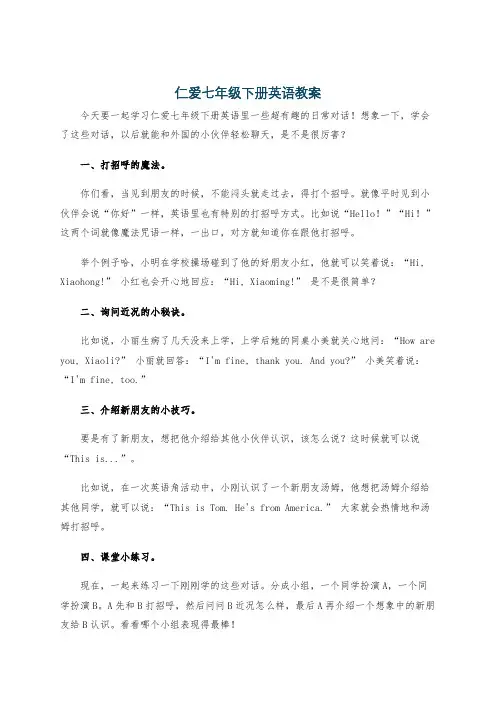
仁爱七年级下册英语教案
今天要一起学习仁爱七年级下册英语里一些超有趣的日常对话!想象一下,学会了这些对话,以后就能和外国的小伙伴轻松聊天,是不是很厉害?
一、打招呼的魔法。
你们看,当见到朋友的时候,不能闷头就走过去,得打个招呼。
就像平时见到小伙伴会说“你好”一样,英语里也有特别的打招呼方式。
比如说“Hello!”“Hi!”这两个词就像魔法咒语一样,一出口,对方就知道你在跟他打招呼。
举个例子哈,小明在学校操场碰到了他的好朋友小红,他就可以笑着说:“Hi, Xiaohong!”小红也会开心地回应:“Hi, Xiaoming!”是不是很简单?
二、询问近况的小秘诀。
比如说,小丽生病了几天没来上学,上学后她的同桌小美就关心地问:“How are you, Xiaoli?”小丽就回答:“I'm fine, thank you. And you?”小美笑着说:
“I'm fine, too.”
三、介绍新朋友的小技巧。
要是有了新朋友,想把他介绍给其他小伙伴认识,该怎么说?这时候就可以说“This is...”。
比如说,在一次英语角活动中,小刚认识了一个新朋友汤姆,他想把汤姆介绍给其他同学,就可以说:“This is Tom. He's from America.”大家就会热情地和汤姆打招呼。
四、课堂小练习。
现在,一起来练习一下刚刚学的这些对话。
分成小组,一个同学扮演A,一个同
学扮演B。
A先和B打招呼,然后问问B近况怎么样,最后A再介绍一个想象中的新朋友给B认识。
看看哪个小组表现得最棒!
英语是不是很有趣?只要多练习,一定能说得越来越好哒!。
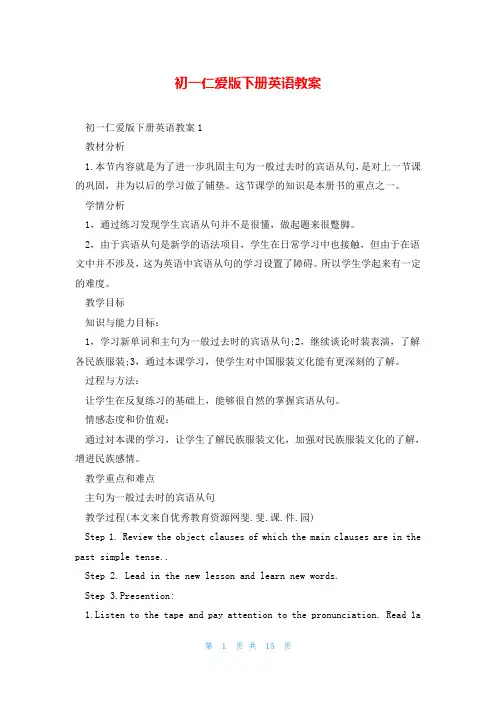
初一仁爱版下册英语教案初一仁爱版下册英语教案1教材分析1.本节内容就是为了进一步巩固主句为一般过去时的宾语从句,是对上一节课的巩固,并为以后的学习做了铺垫。
这节课学的知识是本册书的重点之一。
学情分析1,通过练习发现学生宾语从句并不是很懂,做起题来很蹩脚。
2,由于宾语从句是新学的语法项目,学生在日常学习中也接触,但由于在语文中并不涉及,这为英语中宾语从句的学习设置了障碍。
所以学生学起来有一定的难度。
教学目标知识与能力目标:1,学习新单词和主句为一般过去时的宾语从句;2,继续谈论时装表演,了解各民族服装;3,通过本课学习,使学生对中国服装文化能有更深刻的了解。
过程与方法:让学生在反复练习的基础上,能够很自然的掌握宾语从句。
情感态度和价值观:通过対本课的学习,让学生了解民族服装文化,加强对民族服装文化的了解,增进民族感情。
教学重点和难点主句为一般过去时的宾语从句教学过程(本文来自优秀教育资源网斐.斐.课.件.园)Step 1. Review the object clauses of which the main clauses are in the past simple tense..Step 2. Lead in the new lesson and learn new words.Step 3.Presention:1.Listen to the tape and pay attention to the pronunciation. Read 1ain different ways to learn it2. Let the students answer some questi. And then fill in blanks according to 1a.Step 4. PracticeLead into Part 2and practice the object clauses of which the main clauses are in the past simple tense.Step 5.Colidation :Step 6.Homework:教学环节一,复习二,导入三,呈现四,练习五,巩固六,作业复习宾语从句,然后利用宾语从句引入新课,并展示图片,学习生词,进而学习少数民族服装,处理第三部分。
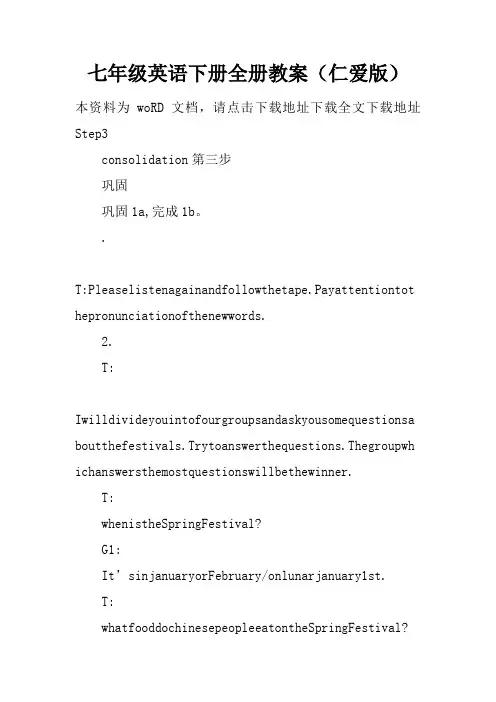
七年级英语下册全册教案(仁爱版)本资料为woRD文档,请点击下载地址下载全文下载地址Step3consolidation第三步巩固巩固1a,完成1b。
.T:Pleaselistenagainandfollowthetape.Payattentiontot hepronunciationofthenewwords.2.T:Iwilldivideyouintofourgroupsandaskyousomequestionsa boutthefestivals.Trytoanswerthequestions.Thegroupwh ichanswersthemostquestionswillbethewinner.T:whenistheSpringFestival?G1:It’sinjanuaryorFebruary/onlunarjanuary1st.T:whatfooddochinesepeopleeatontheSpringFestival?G2:Dumplings.T:Howdopeoplecelebrateit?G3:Performlionanddragondances.T:…G4:……Group234Point3.T:Now,pleasetellmehowpeoplecelebratethosefestivalsacc ordingtotheformontheblackboard.S1:TheSpringFestivalisinjanuaryorFebruary.Peopleeatdum plingsandperformlionanddragondances.S2:christmasisonDecember25th.Peoplegiveeachotherpresen ts.S3:ThanksgivingisonthefourthThursdayinNovember.Familie sgettogetherforabigdinner.Peopleeatturkeyandpumpkin pie.S4:TheLanternFestivalisonlunarjanuary15th.Peopleeatswe etdumplings.Peoplewatchlanternshowsandguessriddleso nlanterns.4.T:Now,let’sdiscussthequestionsof1bingroupsof4.3minuteslater,w e’llasktherepresentativetoreporthisidea.Begin,please.5.T:weeatdumplingsandperformlionanddragondancestocelebr atetheSpringFestival.wecaneatotherthingsonthisday.A ndwecanalsocelebrateinotherways.Forexample,weeatred eggs,riceandnoodles.Andwewearnewclothes.Pleasetellm esomeotherwaystocelebratetheSpringFestival.S5:weeatoranges.S6:weeatricecakes.S7:wevisitfriends.…T:Howaboutsomeotherfestivals?S8:Singchristmassongsatchristmas.S9:Sendcards.…Step4Practice第四步练习练习并完成2。
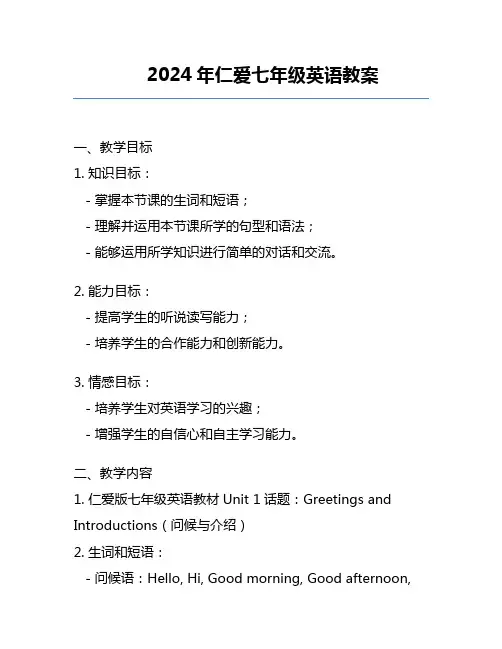
2024年仁爱七年级英语教案一、教学目标1. 知识目标:- 掌握本节课的生词和短语;- 理解并运用本节课所学的句型和语法;- 能够运用所学知识进行简单的对话和交流。
2. 能力目标:- 提高学生的听说读写能力;- 培养学生的合作能力和创新能力。
3. 情感目标:- 培养学生对英语学习的兴趣;- 增强学生的自信心和自主学习能力。
二、教学内容1. 仁爱版七年级英语教材Unit 1话题:Greetings and Introductions(问候与介绍)2. 生词和短语:- 问候语:Hello, Hi, Good morning, Good afternoon,Good evening;- 介绍语:This is ..., My name is ..., I'm ...;- 应答语:Nice to meet you, too.3. 句型和语法:- 疑问句:What's your name? How old are you? Where are you from?- 答句:My name is ..., I'm ..., I come from ...三、教学重点与难点1. 教学重点:- 生词和短语的掌握;- 疑问句和答句的运用;- 日常对话的模拟。
2. 教学难点:- 疑问句的构成和运用;- 语法知识点的理解。
四、教学过程1. 导入- 教师与学生用英语进行简单对话,如询问名字、年龄等,引导学生进入英语学习氛围。
2. 生词和短语学习- 教师展示生词和短语,让学生跟读并模仿;- 学生分组进行生词和短语的接龙游戏,巩固记忆。
3. 句型和语法讲解- 教师通过实例讲解疑问句和答句的构成;- 学生进行句型练习,教师纠正发音和语法错误。
4. 对话模拟- 学生两人一组,模拟日常问候和介绍的场景;- 教师巡回指导,纠正错误,给予鼓励和评价。
5. 小组活动- 学生分组,每组设计一个关于问候和介绍的情景剧; - 各组进行表演,其他组学生观看并评价。
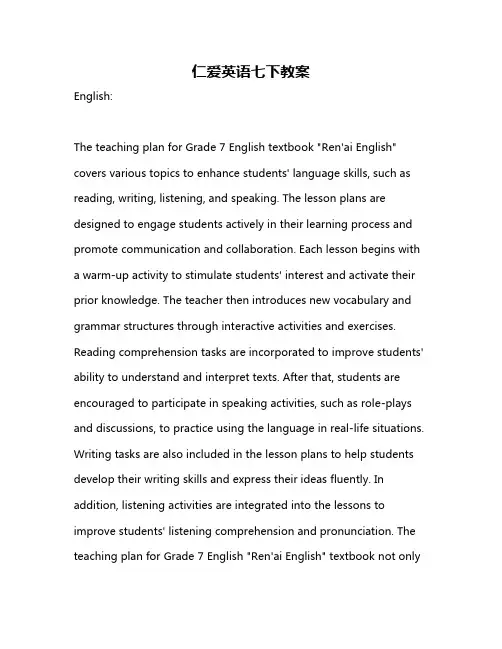
仁爱英语七下教案English:The teaching plan for Grade 7 English textbook "Ren'ai English" covers various topics to enhance students' language skills, such as reading, writing, listening, and speaking. The lesson plans are designed to engage students actively in their learning process and promote communication and collaboration. Each lesson begins with a warm-up activity to stimulate students' interest and activate their prior knowledge. The teacher then introduces new vocabulary and grammar structures through interactive activities and exercises. Reading comprehension tasks are incorporated to improve students' ability to understand and interpret texts. After that, students are encouraged to participate in speaking activities, such as role-plays and discussions, to practice using the language in real-life situations. Writing tasks are also included in the lesson plans to help students develop their writing skills and express their ideas fluently. In addition, listening activities are integrated into the lessons to improve students' listening comprehension and pronunciation. The teaching plan for Grade 7 English "Ren'ai English" textbook not onlyfocuses on language acquisition but also aims to cultivate students' critical thinking, creativity, and intercultural awareness. By the end of the course, students are expected to have improved their English proficiency and developed a deep appreciation for the English language and culture.中文翻译:《仁爱英语》七年级教材的教学计划涵盖了各种主题,旨在提高学生的语言技能,包括阅读、写作、听力和口语。
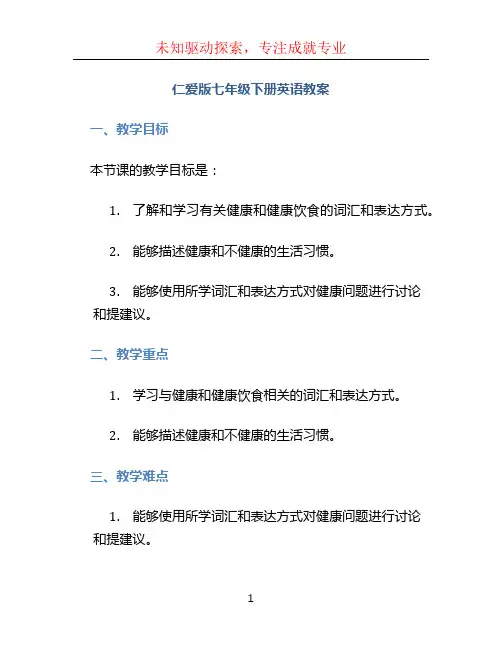
仁爱版七年级下册英语教案一、教学目标本节课的教学目标是:1.了解和学习有关健康和健康饮食的词汇和表达方式。
2.能够描述健康和不健康的生活习惯。
3.能够使用所学词汇和表达方式对健康问题进行讨论和提建议。
二、教学重点1.学习与健康和健康饮食相关的词汇和表达方式。
2.能够描述健康和不健康的生活习惯。
三、教学难点1.能够使用所学词汇和表达方式对健康问题进行讨论和提建议。
四、教学准备1.教师准备好与健康和健康饮食相关的词汇和图片。
2.准备课件和板书。
五、教学过程1. 导入新课教师出示一张健康饮食的图片,让学生观察并讨论:“你能看出这个图片里有哪些食物吗?这些食物看起来健康吗?为什么?”引出学习健康和健康饮食的话题。
2. 学习新词汇教师出示健康和不健康的生活习惯的图片,例如晚上早早睡觉、坚持锻炼、多吃水果和蔬菜等,然后带领学生学习并掌握这些新词汇。
单词词性释义healthy adj.健康的unhealthy adj.不健康的exercise n.锻炼fruit n.水果vegetable n.蔬菜3. 练习新词汇教师设计一些练习题,让学生巩固新词汇的记忆和理解。
1.Fill in the blanks.•Eating too much junk food is __________ for your health.•You should do more __________.•Apples and oranges are __________.•Carrots and tomatoes are __________.2.Translate the following sentences into English.•坚持锻炼对保持健康很重要。
•不要吃太多垃圾食品。
•香蕉是水果,洋葱是蔬菜。
4. 综合训练教师给学生提供一些关于健康问题的情景,让学生用所学词汇和表达方式进行讨论,并提出建议。
情景一:你的同学经常晚上玩电脑游戏,睡眠时间很短,经常感到疲劳和头痛。
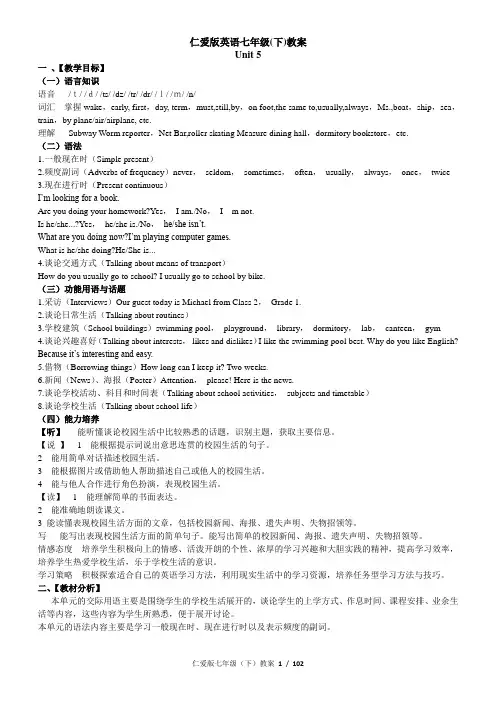
仁爱版英语七年级(下)教案Unit 5一、【教学目标】(一)语言知识语音/t/ /d/ /ts/ /dz/ /tr/ /dr/ /l/ /m/ /n/词汇掌握wake,early, first,day, term,must,still,by,on foot,the same to,usually,always,Ms.,boat,ship,sea,train,by plane/air/airplane, etc.理解Subway Worm reporter,Net Bar,roller skating Measure dining hall,dormitory bookstore,etc.(二)语法1.一般现在时(Simple present)2.频度副词(Adverbs of frequency)never,seldom,sometimes,often,usually,always,once,twice3.现在进行时(Present continuous)I’m looking for a book.Are you doing your homework?Yes,I am./No,I m not.Is he/she...?Yes,he/she is./No,he/she isn’t.What are you doing now?I’m playing computer games.What is he/she doing?He/She is...4.谈论交通方式(Talking about means of transport)How do you usually go to school? I usually go to school by bike.(三)功能用语与话题1.采访(Interviews)Our guest today is Michael from Class 2,Grade 1.2.谈论日常生活(Talking about routines)3.学校建筑(School buildings)swimming pool,playground,library,dormitory,lab,canteen,gym4.谈论兴趣喜好(Talking about interests,likes and dislikes)I like the swimming pool best. Why do you like English? Because it’s interesting and easy.5.借物(Borrowing things)How long can I keep it? Two weeks.6.新闻(News)、海报(Poster)Attention,please! Here is the news.7.谈论学校活动、科目和时间表(Talking about school activities,subjects and timetable)8.谈论学校生活(Talking about school life)(四)能力培养【听】能听懂谈论校园生活中比较熟悉的话题,识别主题,获取主要信息。
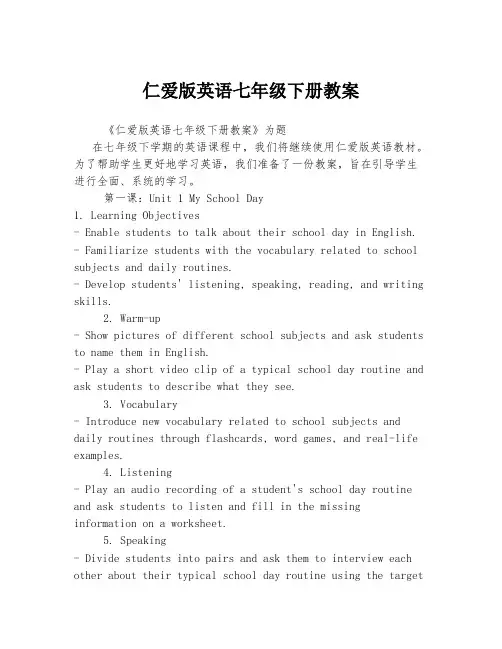
仁爱版英语七年级下册教案《仁爱版英语七年级下册教案》为题在七年级下学期的英语课程中,我们将继续使用仁爱版英语教材。
为了帮助学生更好地学习英语,我们准备了一份教案,旨在引导学生进行全面、系统的学习。
第一课:Unit 1 My School Day1. Learning Objectives- Enable students to talk about their school day in English. - Familiarize students with the vocabulary related to school subjects and daily routines.- Develop students' listening, speaking, reading, and writing skills.2. Warm-up- Show pictures of different school subjects and ask students to name them in English.- Play a short video clip of a typical school day routine and ask students to describe what they see.3. Vocabulary- Introduce new vocabulary related to school subjects and daily routines through flashcards, word games, and real-life examples.4. Listening- Play an audio recording of a student's school day routine and ask students to listen and fill in the missing information on a worksheet.5. Speaking- Divide students into pairs and ask them to interview each other about their typical school day routine using the targetvocabulary.6. Reading- Provide students with a short reading passage about a school day routine and ask them to answer comprehension questions.7. Writing- Ask students to write a short paragraph about their own school day routine, using the vocabulary and sentence structures learned in class.8. Extension Activities- Role play: Divide students into groups and ask them to act out a school day routine, using the target vocabulary and sentence structures.- Vocabulary word search: Provide students with a word search worksheet containing the vocabulary words learned in this unit.第二课:Unit 2 My Hobbies1. Learning Objectives- Enable students to talk about their hobbies in English.- Familiarize students with the vocabulary related to different hobbies.- Develop students' listening, speaking, reading, and writing skills.2. Warm-up- Show pictures of different hobbies and ask students to name them in English.- Play a short video clip of people engaging in different hobbies and ask students to describe what they see.3. Vocabulary- Introduce new vocabulary related to hobbies through flashcards, word games, and real-life examples.4. Listening- Play an audio recording of people talking about their hobbies and ask students to listen and match the hobbies with the correct person on a worksheet.5. Speaking- Divide students into groups and ask them to discuss their favorite hobbies using the target vocabulary. Each group should appoint a spokesperson to present their findings to the class.6. Reading- Provide students with a short reading passage about different hobbies and ask them to answer comprehension questions.7. Writing- Ask students to write a short paragraph about theirfavorite hobby, using the vocabulary and sentence structures learned in class.8. Extension Activities- Hobby showcase: Ask students to bring in an item or a picture related to their favorite hobby and present it to the class, explaining why they enjoy it.- Hobby survey: Divide students into pairs and ask them to conduct a survey among their classmates to find out the most popular hobbies in the class.第三课:Unit 3 My Family1. Learning Objectives- Enable students to talk about their family members in English.- Familiarize students with the vocabulary related to family members and relationships.- Develop students' listening, speaking, reading, and writingskills.2. Warm-up- Show pictures of different family members and ask students to name them in English.- Play a short video clip about a family gathering and ask students to describe what they see.3. Vocabulary- Introduce new vocabulary related to family members and relationships through flashcards, word games, and real-life examples.4. Listening- Play an audio recording of a person talking about their family and ask students to listen and answer comprehension questions.5. Speaking- Divide students into pairs and ask them to interview each other about their family members and relationships using the target vocabulary.6. Reading- Provide students with a short reading passage about a family and ask them to answer comprehension questions.7. Writing- Ask students to write a short paragraph about their own family, using the vocabulary and sentence structures learned in class.8. Extension Activities- Family tree: Ask students to create a family tree, labeling each family member with the appropriate vocabulary words.- Family interview: Divide students into pairs and ask them to interview their family members about their family history, traditions, and customs.本教案只写了前三课的内容,希望能够帮助学生更好地学习英语。
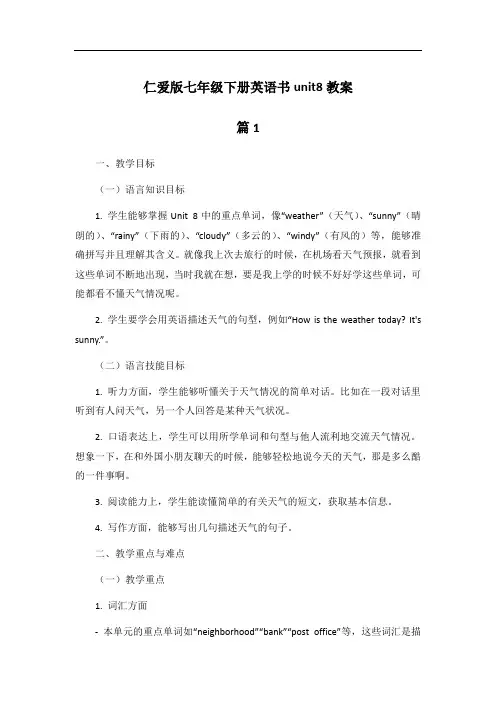
仁爱版七年级下册英语书unit8教案篇1一、教学目标(一)语言知识目标1. 学生能够掌握Unit 8中的重点单词,像“weather”(天气)、“sunny”(晴朗的)、“rainy”(下雨的)、“cloudy”(多云的)、“windy”(有风的)等,能够准确拼写并且理解其含义。
就像我上次去旅行的时候,在机场看天气预报,就看到这些单词不断地出现,当时我就在想,要是我上学的时候不好好学这些单词,可能都看不懂天气情况呢。
2. 学生要学会用英语描述天气的句型,例如“How is the weather today? It's sunny.”。
(二)语言技能目标1. 听力方面,学生能够听懂关于天气情况的简单对话。
比如在一段对话里听到有人问天气,另一个人回答是某种天气状况。
2. 口语表达上,学生可以用所学单词和句型与他人流利地交流天气情况。
想象一下,在和外国小朋友聊天的时候,能够轻松地说今天的天气,那是多么酷的一件事啊。
3. 阅读能力上,学生能读懂简单的有关天气的短文,获取基本信息。
4. 写作方面,能够写出几句描述天气的句子。
二、教学重点与难点(一)教学重点1. 词汇方面-本单元的重点单词如“neighborhood”“bank”“post office”等,这些词汇是描述社区周边设施的基础。
例如,在日常生活中,我们会说“ There is a bank near my neighborhood.”,学生需要准确记忆这些单词的拼写和含义,才能进行有效的交流。
2. 语法方面-一般现在时的用法。
在描述社区里的事物状态或者经常发生的事情时会用到,像“ The postman comes here every day.”这种句子结构,学生要掌握主语是第三人称单数时动词的变化规则。
3. 句型方面-学会用“There be”句型来描述某地有某物。
例如“There are some trees in the park.”这个句型在描述社区环境等场景中经常使用。
仁爱版七年级下册英语教案Unit 1: Countries and LanguagesLesson 1: Introducing Countries and LanguagesObjectives:- To introduce and learn vocabulary related to countries and languages.- To practice asking and answering questions about countries and languages.- To develop listening, speaking, and reading skills. Materials:- Textbook: Ren'ai Grade 7, Unit 1- World map- Flashcards with country names and flags- Handouts with conversation promptsProcedure:1. Warm-up (5 minutes):- Display a world map and ask students to point out different countries.- Ask students to share the names of some countries they know, and elicit their languages.2. Vocabulary Introduction (10 minutes):- Show flashcards with names of countries and their corresponding flags.- Pronounce the country names and have students repeat after you.- Teach the names of the countries and their languages usinggesture and context.- Drill pronunciation of the words.- Make sure students understand the meaning of each word.3. Listening Exercise (15 minutes):- Play an audio recording of a conversation about countries and languages.- Students listen and complete the missing information about the countries and languages.- Play the audio again if necessary.- Check the answers as a class.4. Speaking Practice (15 minutes):- Divide students into pairs.- Provide each pair with a handout containing conversation prompts.- Students take turns asking and answering questions about countries and languages.- Monitor and provide assistance if needed.- Encourage students to use complete sentences and proper pronunciation.5. Reading Comprehension (10 minutes):- Assign the reading passage in the textbook related to countries and languages.- Instruct students to read silently and answer the comprehension questions.- Check the answers as a class.6. Homework (5 minutes):- Assign a written task for homework, such as writing a short paragraph about their favorite country and its language.- Remind students to include relevant vocabulary and proper sentence structure.Assessment:- Observe students' participation and engagement during the speaking practice.- Evaluate students' comprehension through their answers in the listening exercise and reading comprehension.。
20 年----20 年度下学期科目:英语年级:七年级教师:登特科中心校教学进度表课程表时间星期星期一星期二星期三星期四星期五课节8:30--9:10 第1节9:20--10:00 第2节10:10--10:50 第3节11:00--11:40 第4节12:50--13:30 第5节13:40--14:20 第6节14:30--15:10 第7节15:20--16:00 第8节教学计划Step4 Practice (10s) 1.Do 2a. Study the example to understand the two ways of expressing means of transportation. Then fill in the blanks in 2a. Discuss and check the answers.2.Make the students find the rules of two ways of expressing the same meaning by themselves. Help them check the rules.3.Do 2b. Ask and answer questions about the pictures in 2a , using two ways of expressing means of transportation. Help the students to express correctly.4.Do 3. Read the form in 3 before listening. Predict the listening material. Learn the new words: watch TV, soccer/football, movie/film. Then listen to the passage about Nancy’s activities and check the correct answers individually. Then check the answersHomework: Blackboard Design1.Recite 10 words and finish workbook.2.Practice the conversation of 1a;3.Preview Section C-1a. Topic 1 I usually come to school by subway. Section B1. I always get up at six o’clock.2. The early bird catches the worm.3. I usually come to school on foot, but sometimes by bike.I seldom walk to school. I never come to school by subway.2. Li Xiang often comes to school by bike.Li Xiang often rides a bike to school.Thinking after teaching:_________________________________________________________________ _________________________________________________________________ _________________________________________________________________ _________________________________________________________________Topic: Unit 6 Topic 1SectionA Date of Teaching: March 29thTeaching Targets: Knowledge and ability aims:1.Grasp the new words :beautiful, garden, bedroom, second, floor, and so on, upstairs, kitchen, dining room, living room, bathroom, first2.Correctly use bearing prepositions and prepositional phrases,on,next to3.Be able to use the there be pattern to describe the room and the basic furnishings in the scene dialogue;Emotion aims:1.love their living environment;2.To be able to actively cooperate with peers, participate in classroom activities, bold practice.Important &Difficult Points: In the constitutional dialogue, learn to use there be sentence patterns to describe each room and the basic furnishingsTeachingaids:PPT Type New Period: One Steps/Time Teaching Procedures 二次修改Step1 Revision(10 s)Step2 Presentation(10 s) Step3 Consolidatedtion(10 s) 1. Present new words with the help of the flashcards.2. Help the students revise expressions and grammer in lastunit.1.Do 2a & 2b. Listen to the tape of 2a and match thewords or phrases with the pictures in 2a individually.Then check the answers.2.Make up new sentences according to the picture in 2a,using “there be” structure.3.listen to the tape of 1a choose the correct answer in1b,then check the answers.1.Listen to the tape again and fill in the blanks according to1a individually about 1c. Then check the answers .2.Practice 1a in pairs. Then some pairs act out theHelp the students goon learning thewords about thefurniture and homeitems.。
七年级英语下册全册教案(仁爱版)七年级英语下册全册教案(仁爱版)Step 3 Consolidation 第三步巩固(时间:12分钟)巩固1a, 完成1b。
1. (再次播放1a录音, 让学生跟读, 注意新单词的读音。
)T: Please listen again and follow the tape. Pay attention to the pronunciation of the new words.2. (把全班分成4个小组,教师提问。
采用竞争机制, 看哪个小组回答问题最多, 则该小组为优胜小组,从而让学生对节日的日期、食物及相关活动有更深记忆。
完成1b。
) T:I will divide you into four groups and ask you some questions about the festivals. Try to answer the questions. The group which answers the most questions will be the winner.T:When is the Spring Festival?G1:It’s in January or February/on lunar January 1st.T:What food do Chinese people eat on the Spring Festival?G2:Dumplings.T:How do people celebrate it?G3:Perform lion and dragon dances.T:…G4:……(小组里的学生每答对一个问题, 教师在下面表里为该组记上1分。
) Group1234Point3. (让学生根据小黑板上Step 2的表格内容, 复述每个节日。
)T:Now, please tell me how people celebrate those festivals according to the form on the blackboard.S1:The Spring Festival is in January or February. People eat dumplings and perform lion and dragon dances.S2:Christmas is on December 25th. People give each other presents.S3:Thanksgiving is on the fourth Thursday in November. Families get together for a big dinner. People eat turkey and pumpkin pie.S4:The Lantern Festival is on lunar January 15th. People eat sweet dumplings. People watch lantern shows and guess riddles on lanterns.4. (小组讨论。
Unit 5 Our School LifeTopic 1 How do you usually come to school?Section A needs 1 period. Section A需用1课时。
The main activities are 1a and 2a. 本课重点活动是1a和2a。
Ⅰ. Aims and demands目标要求1.(1) Learn some means of transportation:by bike, by subway, by bus, on foot, by plane, by car, by train, by ship, by boat(2) Learn other new words and phrases:gate, the same to, come on, go to school, Ms., grandmother, group2. Learn adverbs of frequency:often, usually, always3. Review the present simple tense.—Do you often come to school by bike?—Yes. I do./No, I don’t.4. Talk about how to go to school.—How do you usually come to school?—I usually come to school by subway./I always come to school by bus.Ⅱ. Teaching aids 教具录音机/交通工具的模型/图片Ⅲ. Five-finger Teaching Plan 五指教学方案Step 1 Review 第一步复习(时间:5分钟)复习日常用语并呈现1a内容。
Ⅳ.疑点探究本课我们学习了介词by表示“用,靠;通过,借助于(方式、手段)”时的用法。
矿产资源开发利用方案编写内容要求及审查大纲
矿产资源开发利用方案编写内容要求及《矿产资源开发利用方案》审查大纲一、概述
㈠矿区位置、隶属关系和企业性质。
如为改扩建矿山, 应说明矿山现状、
特点及存在的主要问题。
㈡编制依据
(1简述项目前期工作进展情况及与有关方面对项目的意向性协议情况。
(2 列出开发利用方案编制所依据的主要基础性资料的名称。
如经储量管理部门认定的矿区地质勘探报告、选矿试验报告、加工利用试验报告、工程地质初评资料、矿区水文资料和供水资料等。
对改、扩建矿山应有生产实际资料, 如矿山总平面现状图、矿床开拓系统图、采场现状图和主要采选设备清单等。
二、矿产品需求现状和预测
㈠该矿产在国内需求情况和市场供应情况
1、矿产品现状及加工利用趋向。
2、国内近、远期的需求量及主要销向预测。
㈡产品价格分析
1、国内矿产品价格现状。
2、矿产品价格稳定性及变化趋势。
三、矿产资源概况
㈠矿区总体概况
1、矿区总体规划情况。
2、矿区矿产资源概况。
3、该设计与矿区总体开发的关系。
㈡该设计项目的资源概况
1、矿床地质及构造特征。
2、矿床开采技术条件及水文地质条件。